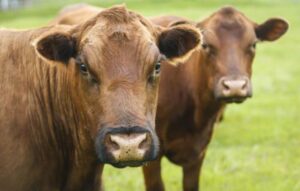COVID having impact on livestock industry
By Tim Kalinowski on February 23, 2021.
 Canadian Press file photo
Cows and their calves graze in a pasture on a farm near Cremona, Alta. in this file photo.
Canadian Press file photo
Cows and their calves graze in a pasture on a farm near Cremona, Alta. in this file photo.LETHBRIDGE HERALDtkalinowski@lethbridgeherald.com
Recent COVID outbreaks at Cargill High River and the Olymel meat packing plant in Red Deer are not yet having a widespread impact on the market, says Chuck MacLean, founder of Porter and MacLean Livestock Management and former chair of Canada Beef and the Alberta Beef Producers, but added to other pressures could lead to even higher consumer prices.
Olymel’s recent temporary closure after a major COVID outbreak will hit pork producers, who have been struggling for awhile already, even harder because it will back up product, MacLean says
“I can’t imagine who could afford to produce pork for what they are trying to sell it for,” says MacLean.
“It has got to be hard on producers. The cattle business so far, we have actually saw a little bit of an increase in demand, and it seems the price of beef is actually stabilized to where there might even be a profit in it. I was going to say there is (a profit), but the price of grain and things like that have got us in a little bit of concern.”
On the beef side, MacLean says it is really been the meat packers’ game for much of the past year as they slowly work through a backlog of oversized 2020 animals.
“The carcass weights have been higher so by default you get more beef,” he confirms. “But we have been working our way through it (2020 stock), and there is a demand for the beef on the consumer side. But where the problem has been is the packers have control over the margins. On the buy side because they have had more cattle than they needed to kill, they have been putting it (the margin) on there pretty tight. But on the other side (consumer side) there has been a shortage of beef so they have got a premium on it. So we haven’t been quite sharing equally, it doesn’t appear.”
This has led to record profits for meat packers and premium prices for grocery giants, he says, while leaving cattle producers and feedlots a bit behind. On that score, MacLean, who also owns South Island Feeders in Bow Island, can speak from painful experience.
“It makes it harder on the feedlots,” he admits.
“They have already been in the red for a couple of months, and now they should be showing black on most of their product now, but for close to 90 days it was pretty ugly there. That’s on the feedlot side, but on the packer side there have been record profits, it appears.”
MacLean says the numbers show ranchers are now starting to take the situation in hand by reducing their feeder cattle herd sizes at the primary producer level, but it will be several months before this helps relieve the glut on the supply side of the cattle business and helps drive the prices up for finished animals.
“It looks like some of the ranchers probably will start to have fewer cows in calf,” he confirms. “But it takes two years for that whole process for the supply to limit itself. To speed up you actually slow down because the heifers you were going to eat you turn them into cows.
“You have fewer in the feedlot because you put them in the pasture.”
MacLean is crossing his fingers there are no other major COVID outbreaks at other large packing plants over the next few months, or at least not all at once like last year.
“This darn disease has been a hassle everywhere you go, and just about the time you think you have a little bit of a handle on it – it comes back and bites you,” he acknowledges. “People look at the packers and say the management at the plant didn’t do enough, but I don’t know that management at the plants would want their people sick either. You need your people there to work, and having them sick is not what you want. You do everything you can to make sure that doesn’t happen, whether people want to believe it or not.”
So far, he says, while slow and steady at meat packing plants might not be ideal for beef producers, feedlots or consumers’ wallets, it is better than the alternative.
“So far they have been running a bit slower, but at least they are running,” he explains. “It is better to be moving at some speed rather than be stopped. If you stop, everything backs up. Those big cattle just keep getting bigger, and the moment they get bigger you create your own problem. You got the same amount of cattle, but more tons of beef to process. And it also takes longer to eat it.
“Instead of eating an eight- ounce steak, you got to eat 16 ounces to get us out of trouble,” MacLean says with a chuckle.
Follow @TimKalHerald on Twitter
4-3


